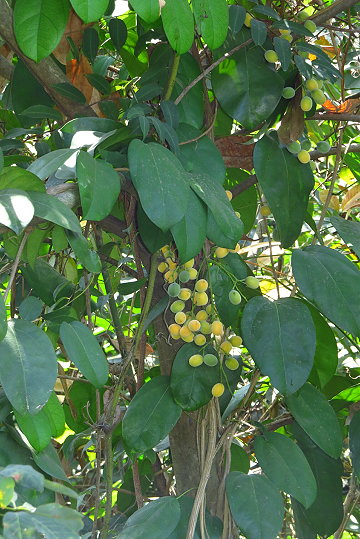
|
|
Akar Kuning (Fibraurea tinctoria).
Leaves and
fruits.
|
Akar Kuning - Fibraurea tinctoria
Fibraurea tinctoria is a species of flowering plant native to South Asia, where it grows in wet tropical areas between India and the Philippines. It is considered locally common. It fruits in April and May, producing yellow-orange drupes. Common names for this plant include yellow root (East Kalimantan), akar palo (Aceh), and akar kuning (Central Kalimantan).
Fibraurea tinctoria is a large woody, entirely glabrous climbing
shrub (liana), producing stems up to 40 metres long and 5cm in diameter. Its stems produce white latex.
Its stalked leaves have thinly leathery leaf blades that are elliptic, elliptic-egg-shaped to egg-shaped or oblong-elliptic. The tri-nerved leaf blades are 9–28 by 3.5–14 cm.
Flowers Its branched flowering spikes are 10–38 cm long. Its sweetly scented unisexual flowers are white or yellow.
Drupes yellow to orange on pedicels, 6–15 mm; endocarp 2–2.5 cm long, wall ca 1 mm thick, hard and rigid. Flowering February–May; fruiting April–May.
Found in both primary and secondary formations in dry evergreen forest; coastal
Forest, peat swamp forest; or in association with bamboo and shrubby vegetation; along river banks and in logged forest; at elevations up to 1,200 metres.
Native Distribution Northeast India, Myanmar, Thailand, Cambodia, Laos, Vietnam, Sumatra, Peninsular Malaysia, Singapore, Java, Borneo, northeast Celebes, and the Philippines.
The plant is sometimes harvested from the wild as a local source of medicines and dyestuff. This species is one of many examples of a dye-producing plant which has completely lost its importance through the advent of chemical dyes. Although it was at one time widely used for dyeing, often being traded, its use nowadays is probably almost exclusively restricted to traditional medicine.
The stem yields a yellow dye used for dying matting made from rattan and colouring cloth. The yellow dye is sometimes mixed with indigo (Indigofera tinctoria) to prepare a green dye.
The dye has been reported as being fairly permanent.
The stems are used medicinally in Malaya and Vietnam.
A decoction of the roots and stems is used to treat dysentery, diabetes, eye diseases and stomach conditions.
The plant has diuretic, analgesic and sedative activity.
The major alkaloid present in roots and stems is palmatine; other alkaloids found include jatrorrhizine, colombamine and magnoflorine.
During a field observation, a male Sumatran orangutan, known to researchers as Rakus, selectively ripped off leaves of a liana with the common name Akar Kuning (Fibraurea tinctoria), chewed on them, and then repeatedly applied the masticated plant material to an open wound on his face. According to primatologists who had been observing Rakus at a nature preserve, "Five days later the facial wound was closed, while within a few weeks it had healed, leaving only a small scar".
Traditionally, the plant has been used by Sumatran islanders as an anti-inflammatory, anti-fungal and anti-bacterial medication. But this was an almost unique observation of a wild animal of any species seeking out a specific plant to cure an injury.
Source:
https://en.wikipedia.org/wiki/Fibraurea_tinctoria
https://tropical.theferns.info/viewtropical.php?id=Fibraurea+tinctoria
https://www.nparks.gov.sg/florafaunaweb/flora/1/4/1401
https://www.discoverwildlife.com/news/orangutan-makes-cream-from-plant
